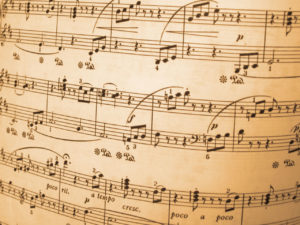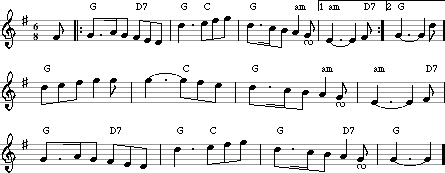From Tune to Arrangement in Five Easy Steps
Music arranging sounds like a complex skill, but if you have a basic understanding of chords and a tune in front of you, you will find that you can create a pleasing arrangement very easily. An arrangement is different than an improvisation in one major way: it is written down and played the same way each time you play it.
What if I’ve never improvised or arranged anything?
Don’t worry, that doesn’t matter at all. You can create your first arrangement by following a few simple steps.
By the way, this page is written with Celtic harpers in mind, but the principles are the same for pedal harp or piano.
Music Arranging: Start with a Tune
For this example, I’m going to start with this tune (click on image for larger version):
This lovely Celtic tune is the one we found and translated into notation by following the directions on the free Celtic sheet music page.
It’s a traditional tune, in the public domain, so anyone is free to arrange it. Once you’ve followed the steps to music arranging and created your own arrangment, you can copyright that, if you want to. A copyrighted arrangement may not be copied, of course, even though the tune itself is traditional.
One more thing, before we start. If you don’t understand how to find the chords that go with the symbols in this score, please visit the music theory page for resources and refer to the Chords on the Scale pdf: building-chords-on-the-scale
Find the key of G major and you will see all the possible chords for that key spelled out in root position. (Ignore the D7 and look at the D chord instead).
Music Arranging for Celtic Harp: 5 Simple Steps
There are five simple steps to music arranging with a tune in hand. They are:
1. Find the chords, and make substitutions if you want to
2. Play with inversions of the chords you’ve chosen
3. Play with chord voicings (open or closed)
4. Play with rhythmic patterns for your LH
5. Put it together by selecting the chords and patterns you like best
The 5 Steps in Detail
Here is a breakdown the the five music arranging steps. Take them one at a time, and if there are things you don’t understand, use the suggested resources to learn or review them.
1. Look at the chords in the score and find each of them on your harp. Try playing the tune through with root position chords in the LH and the melody in the right. Decide if you like all the chords in the score, and make chord substitutions as desired. In our example, I’m going to change one or two of the chords given for chords that I think sound better. Experiment with chords that have two of the three notes of the original chord (for example, C has the same C and E as Am; the C chord includes G while the Am chord includes A). (Visit the Music Theory page for resources to learn about inversions).
2. Play with the chords you’ve chosen in root position, first inversion, and second inversion. Inversions allow you to create a LH that flows from one chord to the next with fewer leaps, and they create different textures with the same three chord tones.
3. Decide if you like closed voicing or open voicing better for most chords. For example, a closed voicing G chord in root position is spelled G, B, D (from the bottom up). An open position chord could be spelled G, D, B (notice the open fifth on the bottom). An even more common spelling for Celtic harp is G, D, G (the second G being the note one octave higher than the root). Most Celtic music sounds more traditional if you leave out the third of the chord.
4. Play with rhythmic patterns. In The Gentle Maiden, the time signature is 6/8, with the measures neatly dividing in 2. This means that breaking the chords naturally creates 2 patterns of three notes (common in the melody itself). The basic rhythmic choices for each half measure are: three eighth notes, an eighth note plus a quarter note, or a dotted quarter note. (Again, you can find all of these demonstrated in the melody line).
To make it slightly more interesting, the melody includes segments where the three eighth notes are replaced by a dotted eighth note, a sixteenth note, and an eighth note. Look, for example, at the first full measure of the tune.
5. Put it all together. For each measure, select the chord inversions and voicings you like best, decide on a rhythmic pattern, and use the notes of the chord to create it.
Once you’ve created the first section, you’ll probably want to repeat it. Repetition provides structure. If you want to use very different patterns, repeat the whole tune with a contrasting accompaniment the second time.
Here is one possible arrangement of this tune:
gentle-maiden
Music Arranging: Common Questions
What if the tune doesn’t come with any chords?
If you’ve never arranged a tune, I suggest either starting with a tune that includes chords, or starting with a simple tune you know well (like Mary Had a Little Lamb). Practice finding chords that fit nicely with tunes. Your ear will tell you if the chord is a good fit or not.
What about fancier arrangements?
I’ve deliberately kept this arrangement as simple as possible, to encourage you to try arranging even if you’ve never done it before. There are, of course, many ways to arrange a tune, complete with multiple verses, chords in the RH, special effects, and so on. I cover some of these in the advanced lesson.



